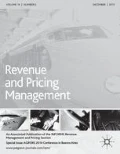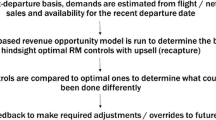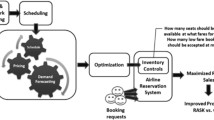Abstract
Techniques for performance measurement are an integral part of a revenue management (RM) system. The Revenue Opportunity Model (ROM) is a widely known method to measure RM performance. However, a traditional ROM does not show valid results for dependent demand structures and for network-based RM controls. While earlier studies focused on the robustness of the network-based ROM with independent demand, this article describes an extension of the network-based ROM to dependent demand structures. Furthermore, we simulate the effect of input data errors on ROM robustness under different scenarios using realistic data of a large network airline and present computational results.












Similar content being viewed by others
References
Belobaba, P.P. and Hopperstad, C.A. (2004) Algorithms for revenue management in unrestricted fare markets. In: AGIFORS Reservations and Yield Management Study Group Annual Meeting Proceedings. Auckland, New Zealand.
Boyd, E.A. and Kallesen, R. (2004) The science of revenue management when passengers purchase the lowest available fare. Journal of Revenue and Pricing Management 3 (2): 171–177.
Bront, J.J.M., Méndez-Díaz, I. and Vulcano, G. (2009) A column generation algorithm for choice-based network revenue management. Operations Research 57 (3): 769–784.
Brumelle, S., McGill, J., Oum, T., Sawaki, K. and Tretheway, M. (1990) Allocation of Airline seats between stochastically dependent demands. Transportation Science 24 (3): 183–192.
Cleaz-Savoyen, R.L. (2005) Airline revenue management methods for less restricted fare structures. Master thesis, Massachusetts Institute of Technology.
Cleophas, C. (2009) Simulation-based analysis of forecast performance evaluations for Airline revenue management. PhD thesis, University of Paderborn.
Cleophas, C., Frank, M. and Kliewer, N. (2009) Recent developments in demand forecasting for airline revenue management. International Journal of Revenue Management 3 (3): 252–269.
Fiig, T. and Isler, K. (2004) SAS O&D low cost project. PODS Consortium Meeting, Minneapolis, MN.
Fiig, T., Isler, K., Hopperstad, C. and Belobaba, P. (2010) Optimization of mixed fare structures: Theory and applications. Journal of Revenue and Pricing Management 9 (1–2): 152–170.
Fiig, T., Isler, K., Hopperstad, R. and Cleáz-Savoyen, R. (2005) DAVN-MR: A unified theory of O&D optimization in a mixed network with restricted and unrestricted fare products. In: AGIFORS Reservations and Yield Management Study Group Annual Meeting Proceedings. Cape Town, South Africa.
Gallego, G., Li, L. and Ratliff, R. (2009) Choice-based EMSR methods for single-leg revenue management with demand dependencies. Journal of Revenue and Pricing Management 8 (2–3): 207–240.
Kimms, A. and Müller-Bungart, M. (2006) Revenue Management unter Berücksichtigung des Kundenwahlverhaltens. Wirtschaftswissenschaftliches Studium 35 (8): 434–439.
Lieberman, W.H. (1991) Making yield management work for you: Ten steps to enhanced revenues. Travel, Tourism, and Hospitality Bulletin of Arthur D. Little, http://www.veritecsolutions.com/Documents/ten_step.pdf.
Ratliff, R.M., Rao, B.V., Narayan, C.P. and Yellepeddi, K. (2008) A multi-flight recapture heuristic for estimating unconstrained demand from airline bookings. Journal of Revenue and Pricing Management 7 (2): 153–171.
Reyes, M.H. (2006) Hybrid forecasting for airline revenue management in semirestricted fare structures. Master's thesis, Massachusetts Institute of Technology.
van Ryzin, G.J. and Vulcano, G. (2008) Computing virtual nesting controls for network revenue management under customer choice behavior. Manufacturing & Service Operations Management 10 (3): 448–467.
Skugge, G. (2004) Growing effective revenue managers. Journal of Revenue and Pricing Management 3 (1): 49–61.
Smith, B.C., Leimkuhler, J.F. and Darrow, R.M. (1992) Yield management at American Airlines. Interfaces 22 (1): 8–31.
Talluri, K.T. and van Ryzin, G.J. (2004a) Revenue management under a general discrete choice model of consumer behavior. Management Science 50 (1): 15–33.
Talluri, K.T. and van Ryzin, G.J. (2004b) Theory and Practice of Revenue Management. Boston, MA: Kluwer Academic Publishers.
Temath, C. (2011) Performance measurement in Airline revenue management – A simulation-based assessment of the network-based revenue opportunity model. PhD thesis, University of Paderborn.
Temath, C., Pölt, S. and Suhl, L. (2010) On the robustness of the network-based revenue opportunity model. Journal of Revenue and Pricing Management 9 (4): 341–355.
Walczak, D., Mardan, S. and Kallesen, R. (2010) Customer choice, fare adjustments and the marginal expected revenue data transformation: A note on using old yield management techniques in the brave new world of pricing. Journal of Revenue and Pricing Management 9 (1–2): 94–109.
Weatherford, L.R. and Ratliff, R.M. (2010) Review of revenue management methods with dependent demands. Journal of Revenue and Pricing Management 9 (4): 326–340.
Winter, T. (2010) Market sensitive revenue optimization: Science and practice. In: GOR Pricing and Revenue Management Working Group Annual Meeting Proceedings. Frankfurt, Germany.
Author information
Authors and Affiliations
Corresponding author
Additional information
4chairs the Decision Support & Operations Research Lab at the University of Paderborn, Germany. Her research focuses on planning for public transport and logistics with special regard to optimization, simulation and robust planning.
Rights and permissions
About this article
Cite this article
Temath, C., Frank, M., Pölt, S. et al. Modelling dependent demand structures in a network-based revenue opportunity model. J Revenue Pricing Manag 12, 162–176 (2013). https://doi.org/10.1057/rpm.2012.19
Received:
Revised:
Published:
Issue Date:
DOI: https://doi.org/10.1057/rpm.2012.19




